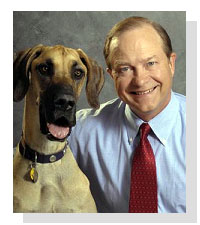Pet Podcasts
- Teacher's Pet
- Oh Behave !!
- Wings 'n Things
- The Pet Doctor
- Travel Tails
- Doggy Dog World
- Lucky's Stars
- Horsing Around
- PetLifeVideo
- Animals Speak
- Pet Peeves
- Cattitude
- Take Me Home
- Pets In The City
- Paranormal Pets
- The Pet Set
- PetTalk Naturally
- Hollywood Pets
- Lizard Lounge
- Off The Hook
- What Were
You Thinking
Check Out






Dr. Jim Humphries
President and News Director
Veterinary News Network

Pudgy Pets Pose Problems for Vets
 ......................................................................
......................................................................
According to the CDC, more than 1 in 4 American adults are overweight and obese. And alongside of us are legions of chubby canines and flabby tabbies! A recent study has shown that half of our dogs and cats are overweight - and that is seriously affecting their health. Heart disease, cancer and diabetes are only a few of the medical concerns. What can be done? Watch this video to learn more about our pudgy pets!

Statistics show that about one in four North American adults are considered obese. But, this epidemic is not limited to our continent nor is it confined to our species. More than half of our dogs and cats are overweight or obese. So, should your pet start an Atkins Diet ?
Ramsey is a “cheese-aholic”. At 6 years old and 156 lbs, this Bull Mastiff listens for his owner to unwrap the cellophane from a cheese slice and then makes a beeline for the refrigerator. Joyce Sternberg, Ramsey’s owner, says originally cheese was an incentive to teach Ramsey to shut the back door. But those cheesy rewards had a darker side.
Ramsey had become so heavy he actually tried to avoid walks. Sternberg states that “Ramsey would just grab the leash and head for home.” His dislike for exercise is a common theme for many pudgy pets.
According to the Association for Pet Obesity Prevention (APOP), 43% of all dogs and 53% of all cats are classified as overweight. What’s worse, an additional 10% of all dogs and 19% of all cats are considered obese! These expanding numbers are a warning sign of our pets’ expanding waistlines!
Joyce Sternberg was lucky in one respect… both her son and her veterinarian warned her about Ramsey’s rotund physique. - - -Similarly, Irene Snow was chided by her veterinarian for allowing her Malamute mix, Yogi Bear, to balloon up to 127 pounds. “My veterinarian said he could tell how much I loved my pet by how fat he was,” says Irene, “but Yogi has always stolen food…that’s how he got his name!” - - - option to remove for length
Veterinarians and pet owners are showing concern over the increase in numbers of portly pets. An overweight pet is more prone to heart problems, poor skin condition, lameness, and more serious illnesses, like diabetes. A ground-breaking study actually details how pets who free feed live an average of two years less than pets with limited calories.
Both Sternberg and Snow realized that their dogs were overweight due to excess treats, like Yogi’s ice cream sundaes or Ramsey's cheeseburgers
Other factors can add to your pet’s propensity for weight gain too. Specific breeds, such as Labradors and Cockers, are at higher risk for becoming chubby as are most non-purebred cats. And, although spaying and neutering your pet won’t make them fat, their metabolism and energy needs actually do decrease. This means that neutered pets are at a higher risk for gaining weight if we don’t pay attention to their diet and exercise.
Without realizing it, many owners contribute to pet obesity through good intentions. “Some pets get twice as many meals each day because no one is in charge of feeding,” says Dr. Steve Hotchkiss, veterinarian and owner of Hulen Hills Animal Hospital.
Hotchkiss challenged Ramsey and Yogi in a “Biggest Pet Loser” contest. Over the course of eight weeks, a newspaper article tracked the pounds that they shed and the trials they endured. Ramsey’s beloved cheese was the first thing to go and Yogi’s new treats consisted of green beans instead of ice cream. Both pets were also encouraged to increase their activity levels.
Changes were apparent within just a few weeks and when the results were announced, both dogs showed significant weight loss. Yogi Bear had lost more than 14 lbs, making him the “Biggest Pet Loser” for the contest. Keeping it off has been more of a challenge though.
Ramsey, on the other hand, continued his progress and eventually lost a total of 32 lbs! He is now at a trim 124 and Sternberg says he has the energy of a puppy. “He’s excited about walks and now he even romps across the yard with our other dog”.
APOP says that pet owners should open a dialogue with their veterinarian about their pet’s weight. Most pet owners know their pet is overweight but many are unsure of how to proceed. The very first step should be a good thorough physical examination and associated blood work. This will help rule out diseases that cause weight gain, like hypothyroidism in dogs.
Next, devise a diet plan with your veterinarian for safely reducing the number of calories being fed while also increasing the calories being burned through activity. Hotchkiss recommends avoiding a self feeder or leaving food out for our pets all day long. Like us, our pets will do better if they eat small meals more frequently rather than one large meal in the evening.
Finally, make exercise a priority. Two or more brisk walks each day for our pudgy pooches and thirty minutes of playtime with your flabby tabby can help them lose that excess weight.
Above all, stay in communication with your veterinarian. You may run into temporary setbacks or even obstacles which will require a revision of your pet’s diet plan. With your love and commitment, your pet can lose that excess poundage which, in turn, could add years to your pet’s life.




